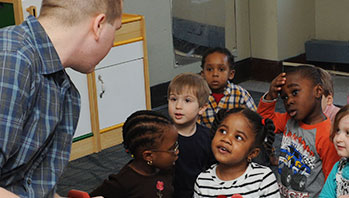- The Little Red Hen (book)
- environment
- grow
- natural
- need
- plant
MA Standards:
English Language Arts/Speaking and Listening/SL.PK.MA.1: Participate in collaborative conversations with diverse partners during daily routines and play.
English Language Arts/Language/L.PK.MA.1: Demonstrate use of oral language in informal everyday activities.
English Language Arts/Language/L.PK.MA.6: Use words and phrases acquired through conversations, listening to books read aloud, activities, and play.
Head Start Outcomes
Language Development/Receptive Language: Attends to language during conversations, songs, stories, or other learning experiences.
Language Development/Expressive Language: Uses language to express ideas and needs.
PreK Learning Guidelines:
English Language Arts/Language 2: Participate actively in discussions, listen to the ideas of others, and ask and answer relevant questions.
Science and Technology/Living Things and Their Environment 17: Observe and describe how natural habitats provide for the basic needs of plants and animals with respect to shelter, food, water, air, and light.
Talk Together: Plant Helpers

© Commonwealth of Massachusetts, Department of Early Education and Care (Jennifer Waddell photographer). All rights reserved.
STEM Key Concepts: Plants have different parts: roots, stems, leaves, and fruit; Plants need water and sunlight to grow; Plants grow in places where they get their needs met
ELA Focus Skills: Listening and Speaking, Vocabulary
Educator Prep: You may want to replay the Between the Lions video “Help” to help children recall the little red hen story.
Ask children to recall the story of the little red hen. Talk about how the little red hen planted and grew the wheat, then ground it into flour to make bread all by herself, without any help. Ask children to share something they did to help at home and encourage them to talk about why they think it is important to help out at home.
Then have children reflect on how they are helping their plants at school. Ask,
- What things are you doing to help our plants to grow?
- What do you think would happen if you didn’t help our plants?
Use this opportunity to explain to children that when we grow plants in pots or in gardens, we do it because we want to meet our own wants and needs (e.g., food to eat, flowers to look at). Explain that growing plants in pots and gardens sometimes means making them grow in a place where they wouldn’t grow naturally, or on their own.
Ask, What about the plants that we explore outside? They don’t need our help because they are in their natural environment—they grow naturally and have their needs met through the environment. Ask questions such as,
- How do the plants we explored outdoors get the water they need to grow?
- How do they get the food they need to grow?
Take It Further: You may want to extend the conversation to include other living things, such as animals. Talk about how wild animals survive in nature on their own, but pets need our help to meet their needs; injured animals may need our help until they can manage on their own.
